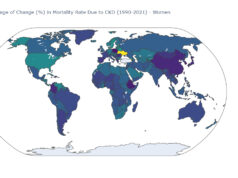 Following the publication of the updated UK Kidney Association (UKKA) clinical practice guidelines on the treatment of acute hyperkalaemia in adults in 2023, Renal Interventions spoke to Annette Alfonzo (Victoria Hospital Kirkcaldy, Fife, UK) about the current state of hyperkalaemia in the UK, what has been updated in the guidelines, and why these changes are so important.
Following the publication of the updated UK Kidney Association (UKKA) clinical practice guidelines on the treatment of acute hyperkalaemia in adults in 2023, Renal Interventions spoke to Annette Alfonzo (Victoria Hospital Kirkcaldy, Fife, UK) about the current state of hyperkalaemia in the UK, what has been updated in the guidelines, and why these changes are so important.
What is the current state of hyperkalaemia and its treatment in the UK?
So, I would say that, if we rewound the clock about 20 years ago, cases of hyperkalaemia were not nearly as frequent as we are seeing now. This is because we are using drugs that can exacerbate hyperkalaemia more widely to treat many conditions like diabetes, heart failure and proteinuric kidney diseases. Moreover, given the prevalence of chronic kidney disease (CKD), the risk of hyperkalaemia is increased further. Hyperkalaemia limits the management of these conditions and this risk has been shown in many clinical trials. Reducing dose or stopping essential medications due to hyperkalaemia has an impact on disease control and patient outcome. There has been a lot of focus on hyperkalaemia for that reason and specialists are now keen to consider new treatments to avoid down-titration of essential drugs. Hyperkalaemia remains common in the acute setting and affects up to 10% of hospital admissions, so developing a guideline to optimise established treatments (insulin/glucose and intravenous [IV] calcium) and incorporate new treatments (potassium binders) for hyperkalaemia was essential.
What are the key updates to the new guidelines?
Our focus was to ensure that we consider patient safety and to make sure we are giving optimal treatment in the right doses, at the right rate, and to the right patients. That was very important when it came to both IV calcium and insulin. The Medicines and Healthcare products Regulatory Agency (MHRA) has looked into intravenous calcium recently, as they were concerned about several adverse events, including deaths in patients with hyperkalaemia that suggested that patients may not have received an adequate dose of IV calcium. They undertook a period of investigation and fact-finding focusing on the dose and rate of administration of IV calcium and they have advised that the Renal Association guideline should be adopted. Our approach to administer an initial dose of 30ml of 10% calcium gluconate intravenously over 10 minutes protects the heart and avoids delay in initiating potassium-lowering treatments.
When we did the previous guidelines in 2020, we had to consider—should we reduce the dose of insulin to reduce the risk of hypoglycaemia? I would say that this was the part of the guideline that we spent the most time deliberating, because the risk of hypoglycaemia using the conventional approach (10 units) was up to 20%—nowadays, would you accept a treatment if you had a 20% chance of getting a really significant side effect? So we worked hard to address this problem and come up with a strategy that reduces hypoglycaemia, yet maintains efficacy. So, our strategy— and it is a big change in practice—is to check the baseline blood sugar before we treat with insulin glucose. From all the studies that have been published, a consistent finding was that the risk of hypoglycaemia was higher in patients with a baseline blood sugar of less than seven. If you treat patients with a follow-on infusion of 10% dextrose for five hours, so it delivers a further 25 grams of glucose, that will reduce the risk of hypoglycaemia over the period that the patients are most at risk of getting hypoglycaemic. I was very reassured that the threshold we chose of less than seven has been supported by several studies since 2020. That is one of the biggest achievements of the UKKA guidelines and it would be interesting to see if this makes an impact in clinical practice and in future studies.
Why are these updates so important, and what is the ultimate goal with these guidelines?
The ultimate goals are to provide an evidence-based approach to management of hyperkalaemia, to reduce variability in clinical practice and to ensure patient safety. Although the guideline is lengthy, it is the only guideline available that covers the whole scope of how hyperkalaemia can present—community, hospital, and resuscitation. Having a targeted focus and summarising in an algorithm for each subchapter makes ours quite user-friendly. The hospital algorithm can be printed and made as part of your inpatient record—and in my hospital that’s what we do. Resuscitation practice has shown that algorithms are quite helpful and they’re good aide mémoires and teaching tools.
I think hyperkalaemia management is different depending on the clinical setting. In the very first guideline in 2014, we didn’t really have a dedicated section for community management. A fair number of cases happen outside of a hospital setting, so it was quite important to make sure that we included management in the community—this means anyone not in an acute hospital bed. So, it could be a GP surgery, outpatient clinic, community hospital, or hospital at home.
So I think when you ask what is the importance of the new guideline, it’s really to make sure that we are using the most current evidence, translating that in a way that people can use it at a bedside, and ensuring that we take steps to reduce avoidable harm like hypoglycaemia.
Is there anything else that needs to be highlighted about these new guidelines or hyperkalaemia in general?
I think that hyperkalaemia is not just a renal problem. It can happen to any acutely unwell patient, as well as patients in a stable, well condition. It can be life-threatening, so vigilance is important. We wanted to create a guideline that makes it easy for the first responder to act. This may be a foundation year one and two trainees, treating a patient in the middle of the night. They need to know the initial steps, when to call for help and ultimately, how to monitor the patient, because it’s not only about monitoring the potassium, it is also about monitoring the heart and the blood sugar level.
I would also add that the UKKA guideline follows a five-step approach; whereas historically, most other reports stop after the first three. We’ve extended to five-stages to embed two further critical steps in every patient’s management—“monitoring” and “prevention”.












